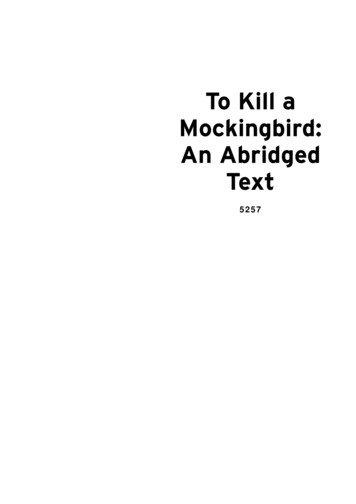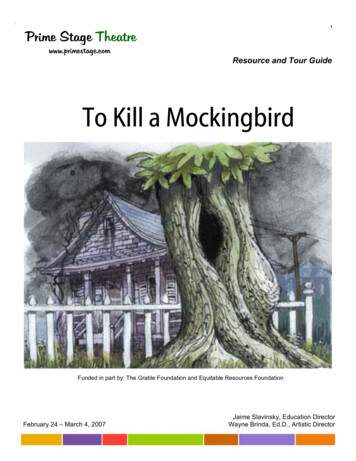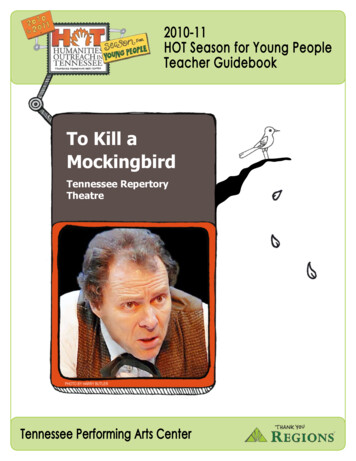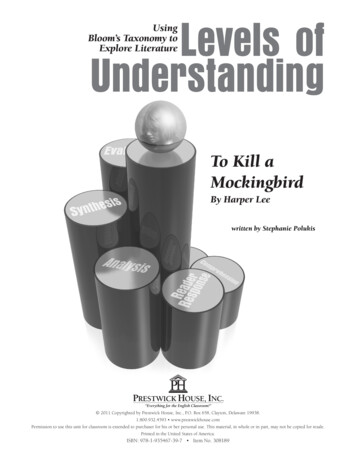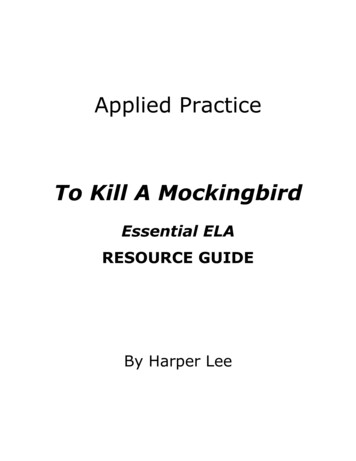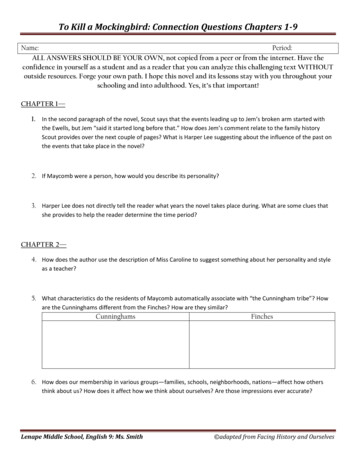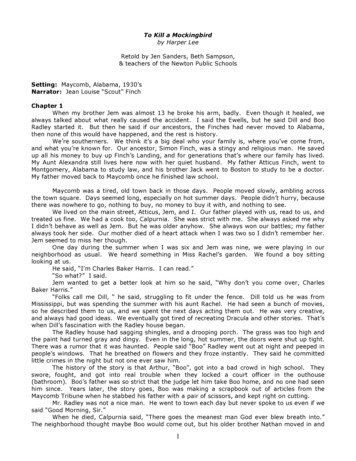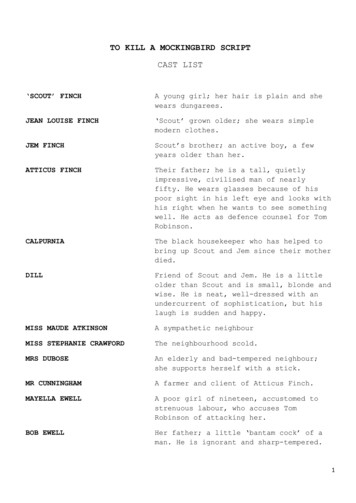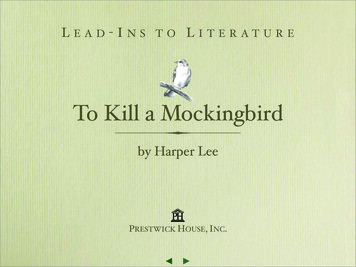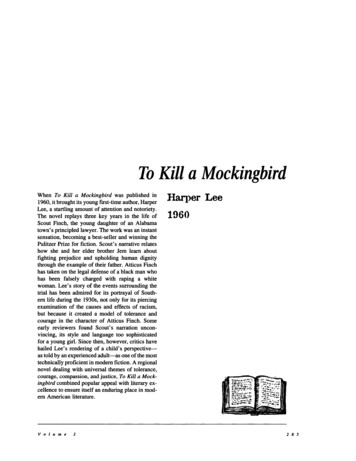
Transcription
To Kill a MockingbirdWhen To Kill a Mockingbird was published in1960, it brought its young first-time author, HarperLee, a startling amount of attention and notoriety.The novel replays three key years in the life ofScout Finch, the young daughter of an Alabamatown's principled lawyer. The work was an instantsensation, becoming a best-seller and winning thePulitzer Prize for fiction. Scout's narrative relateshow she and her elder brother Jem learn aboutfighting prejudice and upholding human dignitythrough the example of their father. Atticus Finchhas taken on the legal defense of a black man whohas been falsely charged with raping a whitewoman. Lee's story of the events surrounding thetrial has been admired for its portrayal of Southem life during the 1930s, not only for its piercingexamination of the causes and effects of racism,but because it created a model of tolerance andcourage in the character of Atticus Finch. Someearly reviewers found Scout's narration unconvincing, its style and language too sophisticatedfor a young girl. Since then, however, critics havehailed Lee's rendering of a child's perspectiveas told by an experienced adult-as one of the mosttechnically proficient in modem fiction. A regionalnovel dealing with universal themes of tolerance,courage, compassion, and justice, To Kill a Mockingbird combined popular appeal with literary excellence to ensure itself an enduring place in modem American literature.V o I u m e2Harper Lee19602 8 5
ToK i l IaM o c k i n g b i r dAlthough Harper Lee has long maintained that ToKill a Mockingbird is not autobiographical, critics have often remarked upon the striking similarities between the author's own childhood andthat of her youthful heroine, Scout Finch. NelleHarper Lee was born in 1926, the youngest ofthree children of Amasa Coleman Lee, a lawyerwho practiced in the small town of Monroeville,Alabama. Like Scout, who could be bullied intosubmission with the remark that she was "gettin'more like a girl," Lee was "a rough 'n' toughtomboy," according to childhood friends. Summers in Monroeville were brightened by the visits of young Truman Capote, who stayed with theLees' next-door neighbors and who later becamea famous writer himself. The games young Nelleand her brother played with Capote were likelythe inspiration for the adventures Scout and Jemhad with Dill, their own "summer" friend.After graduating from the public schools ofMonroeville, Lee attended a small college innearby Montgomery before attending the University of Alabama for four years. She left schoolsix months short of earning a law degree, however, in order to pursue a writing career. In theearly 1950s, the author worked as an airline reservations clerk in New York City, writing essaysakld short stories in her spare time. After her litefary agent suggested that one of her storiesmight be expanded into a novel, Lee quit her airline job. With the financial support of somefriends, she spent several years revising the manuscript of To Kill a Mockingbird before submitting it to publishers. Several more months of revision followed the feedback of her editors, whofound the original version more like a string ofshort stories than a cohesive novel. The final draftwas finally completed in 1959 and published in1960. The novel was a dramatic success, earninggenerally positive reviews and achieving bestseller status. Lee herself attained considerablecelebrity as the novel won the Pulitzer Prize forfiction in 1961 and was made into an Oscar-winning film in 1962. Since then, aside from a fewmagazine pieces in the early 1960s, the reclusiveauthor has published nothing, although she hasbeen reported to have been working on a secondnovel. Despite the lack of a follow-up work, Lee'sliterary reputation remains secure and even hasgrown since the debut of her remarkable firstnovel.2 8 6Harper LeePart OneHarper Lee's To Kill a Mockingbird depictsthe life of its young narrator, Jean Louise "Scout"Finch, in the small town of Maycomb, Alabama, inthe mid-1930s. Scout opens the novel as a grownwoman reflecting back on key events in her childhood. The novel covers a two-year period, beginning when Scout is six and ending when she iseight. She lives with her father, Atticus, a widowedlawyer, and her older brother, Jem (short for Jeremy). Their black housekeeper, Calpurnia, tendsto the children. Scout and Jem' s summer playmate,Dill Harris, shares the Finch children's adventuresand adds imagination and intrigue to their gameplaying. In the novel, we see Scout grow in awareness and come to new understandings about hertown, her family, and herself.During the summer before Scout enters school,the children become fascinated with Arthur "Boo"Radley, a reclusive neighbor. Radley's father, a religious fanatic, confined Boo to the house becausehe was arrested for youthful pranks as a teenager.Some years later, Boo casually stabbed his fatherin the leg with a pair of scissors, confirming people's worst fears about him. The children are naturally afraid of and intrigued by such a "malevoN o v e I sf o rS t u d e n t s
T olent phantom," as Scout calls him. Yet they onlyapproach the house once, when Jem runs andtouches the porch on a dare.Scout enters first grade the following September and must confront new challenges and learnnew ways to deal with people. She cannot understand, for instance, her young teacher's lack of familiarity with the town families and their peculiarities, such as the Cunningham children's povertyand pride. Later, Atticus explains to Scout that shemust put herself in others' places before judgingthem, one of the many lessons she learns by making mistakes.With summer's return, Dill arrives and thechildren's absorption with Boo Radley begins againin earnest. Ultimately, they attempt to look in thehouse to see Boo, but a shotgun blast from NathanRadley, Boo's brother, drives them off. In theirpanic, Jem catches his overalls in the Radley fenceand must abandon them. Later that night, he returnsto retrieve them and finds them neatly folded onthe fence with the ripped fabric poorly resewn.Their contact with Boo Radley continues intothe school year. Before the previous summer, Scoutand Jem had discovered gum and Indian head pennies in a knot-holed tree by the Radley house. Nowmore objects begin to appear in the knothole, including replicas of Scout and Jem carved in soap.They decide to leave a note for whoever is leavingthe objects, but before they can, Nathan Radley fillsthe hole with cement, upsetting Jem.Scout soon encounters trouble at school whena schoolmate condemns Atticus for "defending niggers." Atticus confirms that he is defending a blackman named Tom Robinson, who is accused of raping a white woman, and that his conscience compels him to do no less. He warns her that she willencounter more accusations of this kind and to remember that despite their views, the people whocast slurs at them are still their friends. Atticus latertells his brother Jack that he hopes he can guide hischildren through this time without them becomingbitter and "without catching Maycomb's usual disease" of racism.That Christmas, Atticus gives the children airrifles and admonishes them to shoot no mockingbirds. Miss Maudie Atkinson, their neighbor, explains Atticus's reasons when she says that"Mockingbirds don't do one thing but make musicfor us to enjoy." Hence, it is a sin to kill them. Atthis time, the children feel disappointed in Atticusbecause he is old (almost fifty) and does nothingof interest. They soon learn, however, about one ofV o I u m e2K i I IaM o c k i n g b i r dtheir father's unique talents when he shoots a rabid dog that threatens the neighborhood, killing thebeast with one shot. The neighbors tell them thatAtticus is the best shot in the county, he justchooses not to shoot a gun unless he must. Scoutadmires Atticus for his shooting talent, but Jem admires him for his gentlemanly restraint.Part TwoThe family's involvement in Tom Robinson'strial dominates Part Two of the novel. One personalinconvenience of the trial is the arrival of AuntAlexandra, Atticus's sister, who comes to tend tothe family. Scout finds her presence unwelcome because Aunt Alexandra disapproves of her tomboyish dress and activities and tries to make Scout weardresses and attend women's socials.The time for the trial arrives, and Atticusguards the jail door the night Tom Robinson isbrought to Maycomb. The children, including Dill,sneak out to watch over him and soon become involved in a standoff. Carloads of men drive up anddemand that Atticus let them have Tom Robinson,and he gently refuses. Scout recognizes a schoolmate's father, Mr. Cunningham, and asks him polite questions about his legal debt to Atticus, whodid work for him, and about his son. Scout's innocent questioning of Mr. Cunningham shames him,and he convinces the men to leave.The children also sneak to the courthouse toattend the trial. They sit in the balcony with theblack townspeople because no seats are availableon the ground floor. Atticus's questioning of BobEwell and Mayella Ewell, both of whom claim TomRobinson beat and raped Mayella, reveals their lies.Mayella was beaten primarily on the right side ofher body by a left-handed man. By having BobEwell sign his name, Atticus shows him to be lefthanded. Tom Robinson's left arm, however, is crippled from a boyhood accident. Tom's story ringstruer. He contends that Mayella invited him intothe house and tried to seduce him, a story madecredible by Mayella's and Tom's descriptions ofher lonely life. Tom resisted her advances, but before he could leave Bob Ewell discovered them.Tom ran and Ewell beat Mayella. To avoid socialdisgrace, the Ewells claimed Tom had raped her.Despite the evidence, Tom is convicted. Atticus has expected this verdict and believes he canwin on appeal. Jem has difficulty accepting the injustice of the verdict. Others, however, remain angry over Atticus's sincere defense of Robinson,particularly Bob Ewell. Ewell confronts Atticus,2 8 7
T oK i I IaM o c k i n g b i r dthreatens him, and spits on him. Soon after, TomRobinson's story ends in tragedy as he is shottrying to escape from prison. He ran because he believed he could find no justice in a whitedominated legal system.The following October, Scout dresses as a hamfor the school Halloween pageant. On the wayhome from the pageant, she and Jem are followed,then attacked. Scout cannot see their assailant because of her costume, but she hears Jem grapplingwith him and hears Jem being injured. After theconfused struggle, she feels a man lying on theground and sees another man carrying Jem. She follows them home. The doctor arrives and assuresher that Jem is alive and has suffered only a broken arm. The man who carried him home is standing in Jem's room. To Scout's tearful amazement,she realizes that he is Boo Radley. Sheriff HeckTate informs them that Bob Ewell attacked themand that only Scout's costume saved her. Ewellhimself now lies dead, stabbed in the ribs. Atticusbelieves Jem killed Ewell in self-defense, but Tatemakes him realize that Boo Radley actually stabbedEwell and saved both children's lives. The menagree to claim that Ewell fell on his knife in orderto save Boo the spectacle of a trial. Scout walksBoo home:He had to stoop a little to accommodate me, but ifMiss Stephanie Crawford was watching from her upstairs window, she would see Arthur Radley escorting me down the sidewalk, as any gentleman woulddo.We came to the street light on the corner, and I wondered how many times Dill had stood there huggingthe fat pole, watching, waiting, hoping. I wonderedhow many times Jem and I had made this journey,but I entered the Radley front gate for the secondtime in my life. Boo and I walked up the steps to theporch. His fingers found the front doorknob. He gently released my hand, opened the door, went inside,and shut the door behind him. I never saw him again.Neighbors bring food with death and flowers withsickness and little things in between. Boo was ourneighbor. He gave us two soap dolls, a broken watchand chain, a pair of good-luck pennies, and our lives.But neighbors give in return. We never put back intothe tree what we took out of it; we had given himnothing, and it made me sad.She returns home to Atticus, who stays up allnight waiting for Jem to awake.Miss Maudie AtkinsonMaudie Atkinson is a strong, supportivewoman who lives across the street from theFinches. A forthright speaker, she never condescends to Jem and Scout, but speaks to them asequals. It is Miss Maudie who affirms that it is asin to kill a mockingbird, since "they don't do onething but sing their hearts out for us." A respectedcommunity member who often teasingly reproaches the children, Miss Maudie neverthelesshas a impish streak: she likes to quote scriptureback to conservative religious folk who frown onher brightly colored garden. Miss Maudie providesanother example of bravery to the children whenher home bums down. Instead of lamenting herfate, she tells Jem she looks forward to rebuildinga smaller house which will have more room for herflowers.Mr. AveryA good-natured if somewhat coarse neighborof the Finches who helps fight the fire at MissMaudie's house at risk to his own life.CalpurniaOne of several strong female figures in thelives of the Finch children, Calpumia is the family's black housekeeper. She has helped to raiseJem and Scout since their mother's death four yearsago. Like Atticus, Calpumia is a strict but lovingteacher, particularly in regard to Scout, whose enthusiasm sometimes makes her thoughtless. OnScout's first day of school, for example, Calpumiascolds Scout for criticizing the table manners ofWalter Cunningham Jr., whom the children havebrought home as a lunch guest. That day afterschool, however, Calpumia prepares Scout's favorite food, crackling bread, as a special treat.Calpumia also gives Scout her first awareness ofthe contrast between the worlds of black and white.During a visit to Calpurnia's church, her use ofblack dialect with her friends makes Scout realizethat Calpurnia has a wider life outside the Finchhousehold. Calpumia also helps Scout understandhow people can serve as a bridge between thesediffering worlds. Although the majority of parishioners welcome them during their church visit, onewoman challenges the white children. Calpumia responds by calling them her guests and saying "it'sthe same God, ain't it?"Stephanie CrawfordAunt AlexandraSee Alexandra Finch Hancock2 8 8The "neighborhood scold" who is alwaysready to gossip about anything or anyone.N o v e I sf o rS t u d e n t s
T oK i I IaM o c k i n g b i r dFrom the film To Kill a Mockingbird, starring Gregory Peck, Mary Badham, Phillip Alford, and JohnMegna, 1962.Walter Cunningham Jr.Bob EwellA local farmer who hires a lot of black helpand once employed Tom Robinson.The head of family who's been "the disgraceof Maycomb for three generations," Bob Ewell isdespised by Maycomb society as a shiftless drunkard. He is unable to keep a job, spends all his relief money on alcohol, and traps animals outside ofhunting season. He provides little support to hislarge, motherless family, and is reputed to beat hischildren (and perhaps sexually abuse them too, asMayella's testimony hints). Angered and shamedby his exposure on the witness stand, Ewell makesthreats to Atticus and others involved in the trial,but never risks direct confrontation. This cowardicereaches its peak in his violent attack on Scout andJem, during which he is killed by Boo Radley.Mrs. Henry Lafayeffe DuboseMayella EwellAccording to Scout, Mrs. Henry LafayetteDubose is "the meanest old woman who everlived." She regularly insults and harasses the children as they walk by. When Jem wrecks her garden in retaliation for a nasty remark about his father, Atticus punishes him by forcing him tospend many hours reading to her. She dies laterthat year, and Jem learns that his reading helpedher to courageously defeat an addiction to morphine.The eldest daughter of Bob Ewell, MayellaEwell lives a lonely life keeping house for her father and seven siblings without assistance. Although she can only afford small gestures such asa potted plant, Mayella tries to brighten her situation and the lives of her siblings. During the trialit is revealed that Tom Robinson's occasional stopsto help her with heavy chores were her only contact with a sympathetic soul. When Bob Ewell discovers Mayella's attempt to seduce the unwillingA poor but proud classmate of Scout's.Walter Cunningham Sr.Walter Cunningham, Sr., is a member of a poorfamily who "never took anything they couldn't payback." A former client of Atticus's, he paid for legal service with goods such as firewood and hickory nuts. After Scout recognizes him in the potential lynch mob and speaks to him of his son, heleads the crowd away from violence.Link DeasV o I u m e22 8 9
T oK i I IaM o c k i n g b i r dIMediaAdaptations**To Kill a Mockingbird was adapted as a film byHorton Foote, starring Gregory Peck and MaryBadham, Universal, 1962; available from MCA/Universal Home Video.It was also adapted as a full-length stage playby Christopher Sergel, and was published asHarper Lee's To Kill a Mockingbird: A Fulllength Play, Dramatic Publishing Co., 1970.Henry Lafayette Dubose, a neighbor who scoldsand insults the children, Atticus sentences him toread to her each day. As Jem reads, he and Scoutwitness the dying woman's battle against her morphine addiction and learn the true meaning ofcourage: "it's when you know you're licked beforeyou begin but you see it through no matter what,"Atticus tells them. Atticus's own actions in arguing the Robinson case demonstrate this kind ofcourage, and his behavior throughout embodiesvalues of dignity, integrity, determination, and tolerance. Although Atticus's character is somewhatidealized, critic William T. Going calls Lee's creation "the most memorable portrait in recent fiction of the just and equitable Southern liberal."Jack FinchSee John Hale FinchJean Louise FinchTom, his violent outburst leads her to accuse Tomof rape. Despite her situation, she loses the reader'ssympathy when she repays Tom's kindness withopen contempt and a lie that costs him his life. Thefact that the jury accepts her word over his, evenwhen it is demonstrated to be false, further illustrates the malicious power of racist thinking.Mrs. Gertrude FarrowOne of the hypocritical members of AuntAlexandra's missionary circle.Afficus FinchAtticus Finch, Scout's widowed father, is amember of one of Maycomb County's oldest andmost prominent families. Nevertheless, he refusesto use his background as an excuse to hold himselfabove others and instead is a model of toleranceand understanding. Atticus is a lawyer and also amember of the state legislature, elected by townspeople who respect his honesty even if they don'talways approve of his actions. For example, whenAtticus is appointed the defense attorney for TomRobinson, a black man accused of raping a whitewoman, the town disapproves because he aims todo the best job he can. As a father Atticus is affectionate with Jem and Scout, ready with a hugwhen they need comfort and available to spend timereading to them. Although he allows his childrenfreedom to play and explore, he is also a firm disciplinarian, always teaching his children to think ofhow their actions affect others and devising punishments to teach his children valuable lessons.When Jem damages the camellia bushes of Mrs.2 9 0The narrator of the novel, Jean Louise "Scout"Finch is almost six years old at the time her storybegins. A tomboy most frequently clad in overalls,Scout spends much of her time with her olderbrother Jem and is constantly trying to prove herself his equal. Throughout the book Scout maintainsan innocence and an innate sense of right and wrongthat makes her the ideal observer of events, even ifshe doesn't always fully understand them. She naturally questions the injustices she sees instead ofaccepting them as "the way things are." For instance, she doesn't understand why her aunt makessocial distinctions based on "background" whenScout thinks "there's just one kind of folks: Folks."Her independence and outspokenness often getScout into trouble, however; she is quick to respondto insults with her fists and frequently opens hermouth at inappropriate moments, as when sherudely remarks on the table manners of a guest. Bythe end of the novel, however, eight-year-old Scouthas learned a measure of restraint, primarily throughthe influence and example of her father Atticus.Jem FinchSee Jeremy FinchJeremy FinchFour years older than his sister Scout, Jeremy"Jem" Finch seems to have a deeper understandingof the events during the three years of the novel, forhis emotional reactions to them are stronger. As thestory begins, Jem is a quick-witted but funloving ten year old who spends a lot of time in creative play with Scout and Dill Harris, a summervisitor to the neighborhood. Jem is frequently exN o v e I sf o rS t u d e n t s
T oasperated by his sister, and requires her to keep herdistance during school hours. Nevertheless, for themost part Jem is an understanding and encouragingolder brother, allowing Scout to join in his gamesand even dignifying her with an occasional fistfight.He is anxious to please his father, and hates to disappoint him. When Jem loses his pants in the "raid"on the Radley house, he insists on returning for themduring the middle of the night-not so much toavoid the pain of punishment, but because "Atticusain't ever whipped me since I can remember. Iwanta keep it that way." As he approaches adolescence, however, Jem becomes quieter and more easily agitated: he reacts angrily when Mrs. Duboseleaves him a small peace offering after her death.Although more socially aware than Scout, he is genuinely surprised at Tom Robinson's guilty verdict.The trial leaves Jem a little more withdrawn andless self-confident, and he spends much of the following fall concerned for his father's safety. Hedemonstrates his own courage, however, when heprotects his sister from the attack ofBob Ewell without regard for his own safety.K i I IaM o c k i n g b i r dinfluence on his children by reminding them oftheir family's eminence and by trying to makeScout behave in a more ladylike manner. When shemoves in with Atticus's family, her efforts to reform Scout include requiring her attendance at regular meetings of a "missionary circle," whose discussions focus on improving the lives of "heathens"in distant Africa rather than on the needy in theirown town. Aunt Alexandra is not completely unsympathetic, however; she also shows-in private-some anger towards the hypocrites in hermissionary circle. Although she disapproves of Atticus's role in the Robinson case, she becomes upset upon hearing news of Robinson's death duringone of her parties. Her ability to continue on leadsScout to state that "if Auntie could be a lady at atime like this, so could I."Francis HancockScout and Jem's cousin and Alexandra'sgrandson.Charles Baker HarrisScout's first-grade teacher who is a newcomerto Maycomb. She misunderstands the social orderof Maycomb and punishes Scout for trying to explain it. She also comes into conflict with Scout because of the girl's reading ability.Small and devilish, Charles Baker "Dill" Harris is Scout and Jem's summer friend. He instigatesmuch of the children's mischief by daring Jem toperform acts such as approaching the Radley house.He seems to have a limitless imagination, and hisappeal is only enhanced by his firsthand knowledgeof movies such as Dracula. Seemingly ignored (butnot neglected) by his parents, Dill enjoys his yearlyvisits to his aunt, Rachel Haverford, who lives nextdoor to the Finches-he even runs away from homeone summer to come to Maycomb. A year olderthan Scout, Dill has declared he will one day marryher, a statement she seems to accept matter-offactly.Miss GatesDill HarrisJohn Hale FinchAtticus's younger brother, a doctor who leftMaycomb to study in Boston.Scout FinchSee Jean Louise FinchMiss Caroline FisherSee Charles Baker HarrisScout's hypocritical third-grade teacher whocondemns Hitler's persecution of the Jews even asshe discriminates against her own students andcomplains about blacks "getting above themselves."Rachel HaverfordMr. GilmerGrace MerriweatherThe circuit prosecutor from Abbottsville wholeads the case against Tom Robinson.A member of Alexandra's missionary circlewho has a reputation as the "most devout lady inMaycomb" even though she is a hypocritical bigot.Alexandra Finch HancockAtticus's sister, Alexandra Finch Hancock, isa conservative woman concerned with social andclass distinctions and bound to the traditions of theSouth. She tries to counteract her brother's liberalV o I u m e2Dill Harris's sympathetic aunt, who lives nextdoor to the Finches.Arthur RadleyArthur "Boo" Radley has a strong presence inthe novel even though he isn't seen until its lastpages. A local legend for several years, Boo is ru2 9 1
T oK i IlaMo c k i n g b i r dmored to wander the neighborhood at night anddine on raw squirrels and cats. He has spent the lastfifteen years secluded in his own house. An adolescent prank led his late father to place him underhouse arrest. His sinister reputation stems from alater incident, when it was rumored that he stabbedhis father in the leg with a pair of scissors. Boo becomes a central figure in the imaginations of Scout,Jem, and their neighbor Dill Harris, for their summers are occupied with dramatic re-creations of hislife and plans to lure "the monster" out of his house.Despite his history of being abused by his father,Boo is revealed to be a gentle soul through his unseen acts: the gifts he leaves in the tree; his mending of Jem's torn pants; the blanket he puts aroundScout the night of the fire; and finally, his rescueof the children from Bob Ewell's murderous attack.The children's fear of Boo Radley, based on ignorance rather than knowledge, subtly reflects theprejudice of the town against Tom Robinson-aconnection mirrored in the use of mockingbird imagery for both men.Heck TateThe sheriff of Maycomb who is sympathetictowards Atticus and who insists on keeping BooRadley's role in the death of Bob Ewell a secret.Judge John TaylorThe deceivingly sleepy but fair judge whosesympathy for Tom Robinson can be seen in the factthat he appointed Atticus, whom he knew woulddo his best, as Robinson's public defender.Uncle JackSee John Hale FinchB. B. UnderwoodSee Braxton Bragg UnderwoodBraxton Bragg UnderwoodThe owner and editor of the local newspaperwho was ready to defend Atticus and Tom Robinson from the lynch mob with a shotgun even thoughhe is known to "despise" black people.Boo RadleySee Arthur RadleyNathan RadleyBoo's hardhearted older brother who spoilsBoo's secret game with the children by filling theempty treehole with cement.Dolphus RaymondA local man from a good white family withproperty who has a black mistress and children. Hefosters a reputation as a drunk to give townspeoplea reason to excuse his flaunting of social taboos.Tom RobinsonTom Robinson is a mild-mannered, conscientious black man whose kind acts earn him onlytrouble when Mayella Ewell accuses him of rape.Because he saw she was left alone to maintain thehousehold without any help from her family, he often performed small chores for her. During his testimony, he relates that he felt sorry for the girl. Thisremark affronts the white men in the jury, who seeit as evidence that he is overreaching his social station. Although he is clearly proven innocent, theall-white jury convicts him of rape, a crime punishable by death. Unconvinced that he can find justice on appeal, Robinson attempts to escape fromhis prison camp and is shot dead.Reverend SykesThe minister of Maycomb's black church.2 92Prejudice and ToleranceComprising the main portion of the book's examination of racism and its effects are the underlying themes of prejudice vs. tolerance: how people feel about and respond to differences in others.At one end of the spectrum are people who fearand hate, such as the members of the jury who convict an innocent man of rape because of his race.Atticus and Calpumia, on the other hand, show understanding and sympathy towards those whomight be different or less fortunate. When Scoutbrings a poor classmate home for dinner and thenbelittles his table manners, for instance, Calpumiascolds her for remarking upon them and tells hershe is bound to treat all guests with respect no matter what their social station. Atticus similarly baseshis opinions of people on their behavior and nottheir background. Unlike Alexandra, who callspoor people like the Cunninghams "trash" becauseof their social station, Atticus tells his children thatany white man who takes advantage of a blackman's ignorance is "trash."Guilt and InnocenceClosely linked to these themes of prejudice areissues of guilt and innocence, for the same ignorance that creates racist beliefs underlies assumpN o v e I sf o rS t u d e n t s
T otions of guilt. The most obvious instance is the caseof Tom Robinson: the jury's willingness to believewhat Atticus calls "the evil assumption . that allNegroes are basically immoral beings" leads themto convict an innocent man. Boo Radley, unknownby a community who has not seen or heard fromhim in fifteen years, is similarly presumed to be amonster by the court of public opinion. Scout underscores this point when she tells her Uncle Jackhe has been unfair in assigning all the blame to herafter her fight with Cousin Francis. If he hadstopped to learn both sides of the situation he mighthave judged her differently-which he eventuallydoes. The novel's conclusion also reinforces thetheme of guilt and innocence, as Atticus readsScout a book about a boy falsely accused of vandalism. As Scout summarizes: "When they finallysaw him, why he hadn't done any of those things.Attic
To Kill a Mockingbird When To Kill a Mockingbird was published in 1960, it brought its young first-time author, Harper Lee, a startling amount of attention and notoriety. The novel replays three key years in the life of Scout Finch, the young daughter of an Alabama town's principled lawyer. The work was an instant

